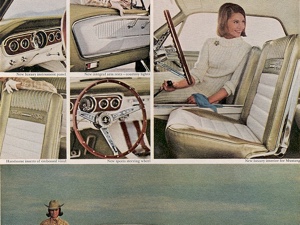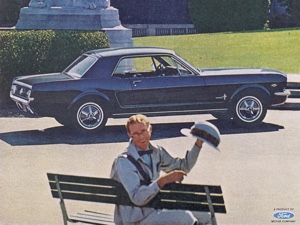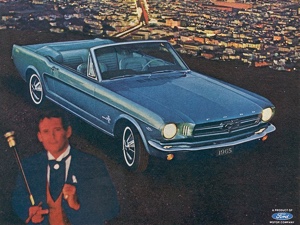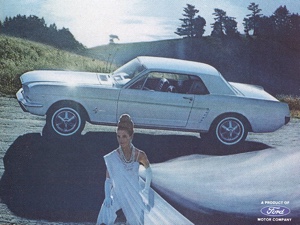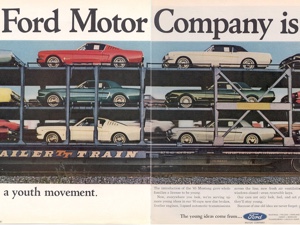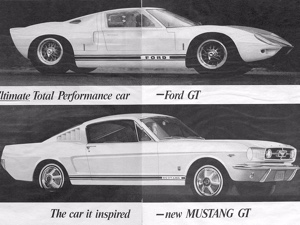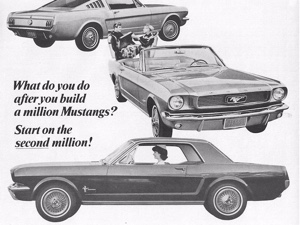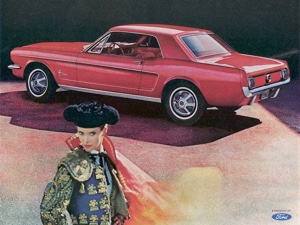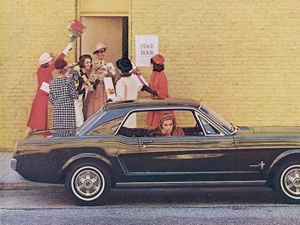1965 Mustang Information
The 1965 Mustangs - A Highly Anticipated Sequel
As is typical with car release dates, the 65 Mustangs were introduced in September of the previous year. What was not so typical was the fact that Ford had just released a 1965 Mustang version six months prior, in April of the same year. Thus, the earlier pace car version is still known as the 64 1/2, whereas the 1965 Ford Mustang version is known as the late model '65 Mustang. It can get a bit confusing, but hopefully we've clarified it for you.
Ford had rushed to get the 64 1/2 prototype out to the general public, with the announcement that the Mustang would be the Indianapolis pace car of 1964. In an effort to keep cost down and speed up production, Ford borrowed a few parts from their earlier models, namely the Ford Falcon. 1966 was the last year that Ford used these parts and in 1967 the Mustang was revised and made more uniquely it's own.
It seems apparent that Ford's marketing plan was highly sucessful. After giving away 195 1964.5 hardtop Mustangs, Ford then sold 1965 hardtop Mustangs at a 5 to 1 ratio over convertibles and fastback versions. Today, this makes good news for 1965 fastback owners as it is a rarer find. The fastback may not have sold as well in 1965, but it provided a basis for the future Mustang Shelby GT350 which was housed in fastback Mustangs. The 65 fastback was referred to as the "2x2 fastback" because although it was intended as a two person car it had room for two more in the fold down rear seat.
Introduced April 17th, 1964 at the World’s Fair in Flushing Meadows, New York, the 1965 Mustang was first available as either a coupe or convertible. The fastback became available in September of 1964.
All Mustangs built between March of 1964 and August 17th, 1964 are considered “early 1965” model Mustangs (a.k.a.: “sixty-four and a half”). The 260 cubic inch V-8, engine (engine code “F”) was standard equipment on early ‘65 models, with an optional 289 cubic inch V-8 available (engine code “D”). Also available in early ‘65 models was a 170 cubic inch, six cylinder engine (engine code “U”), and in June of 1964, the 289 cubic inch “Hi-Po” engine (engine code “K”) became available. A three speed manual transmission was standard equipment, and four speed manual transmission and three speed automatic (the “C4”) were options.
Mustangs built after August 17th 1964 are “late 65” models. Engine options for late 65’s were improved to include a standard 289 cubic inch engine with a 2 barrel carburetor (engine code “C”) replacing the 260 cubic inch engine, with an optional 289 cubic inch engine and a 4 barrel carburetor (engine code “A”) available. A 200 cubic inch in-line six cylinder replaced the 170 cubic inch in-line six cylinder which was available in the early 65 models. The 289 “Hi-Po” (engine code “K”) continued as a late ’65 option.
Here’s a summary of the changes from early to late ’65 models:
Exterior:
- 14" wheels standard
- Improved "crimped" hood after August of 64
- Headlight bezels were not beveled after August of 64
- GT group became available - five-dial instrumentation, disc brakes, larger sway bars, quicker steering ratio, dual exhaust which exited through the rear valance panel, grill mounted fog lights, and special lower body side stripes.
Under the Hood:
- Alternator charging system
- Smaller horns mounted on radiator support
- New engines - 200 CI 6 cyl., 289 V-8 2V, 289 V-8 4V, 289 V-8 Hi-Po 4V
- Aluminum water pump replaced with Cast-iron on 289 Hi-Po
- Six-bolt bell housing on V-8s to improve noise and vibration
- Wider transmission bolt pattern improved vibration and noise levels
- Ford manufactured power steering pump replaced Eaton
- All pulleys were stamped steel
Interior:
- Brake light switch moved under dash
- Wall-to-wall carpeting replacing vinyl between rocker panel and sill plates
- Vent knob is unmarked
- Upgrade from two to three-speed fan switch
- All models featured chrome lock buttons
- New door handles starting March 1965)
- Pony interior became available (special seat covers with running horses)
- Interior door panels with integral arm rests and pistol grip door handles
- Five gauge instrument cluster
- Wood grain steering wheel
Trunk:
- Weather tight taillight socket
- Improved "J-hook" spare tire hold-down
A new interior option was added, the interior decor group (known as the pony interior), which featured special seat covers with running horses across the back, special interior door panels with integral arm rests and pistol grip door handles, five gauge instrument panel, wood grain steering wheel, and wood grain appliques on the instrument cluster, glove box, and optionally on the center console.
Another option introduced in April of 1965 was the GT equipment group. Available only with one of the two four barrel engines, the GT group included five-dial instrumentation, disc brakes, larger sway bars, quicker steering ratio, dual exhaust which exited through the rear valance panel, grill mounted foglights, and special lower body side stripes.
Special Edition 1965 Mustangs
1965 MUSTANG GT
The 1965 GT Mustang was available in hardtop, convertible or fastback. It also came with the option of a 225 or 271hp V-8 engine and a 3 or 4 speed manual or cruise-o-matic transmission.
Cosmetically, it featured GT a (gran turismo/grand touring) badge on the lower front fender and the low stripes. Driving lights located in the grille and dual exhausts were an option for regular 65 Mustangs but they came standard in the GTs.
The rally-pac instrument cluster of tach and clock was a popular option in 1965 and became standard in all 66GTs.
1965 Mustang Shelbys
The 1965 Mustang Shelby was debuted in January of 1965. This was a later release than the 1964 1/2 and the 1965 Mustang, which debuted in April and September of 1964. All 1965 Mustang Shelbys were fastback models and came with no rear seat. The idea was to produce a model specifically geared toward racing.
The '65 Mustang Shelby came in two versions; the GT350 street model and the GT350R racing edition. Some of the modifications of these Shelby editions included a Shelby grille, a fiberglass hood with a functional air scoop and racing pins, racing mirrors, louvers, side exhaust and side markings of G.T.350. On the inside you'd find a three spoke steering wheel, a tachometer, oil pressure gauge and racing style seat belts. The horn was located as a switch on the dash since it didn't fit well with the race style steering wheel. These Mustang GT350s were also only available in white with dark blue racing stripes.
Compared with the price of the original Mustang, the GTs were pricey! The street version retailed at $4,547 compared with the Mustang base price of $2,320. Only 516 of these street model Mustang GTs were made, making them a highly sought after vintage car today!
1965 Mustang Ads
